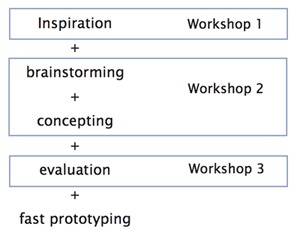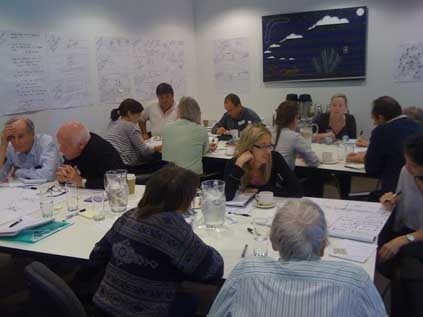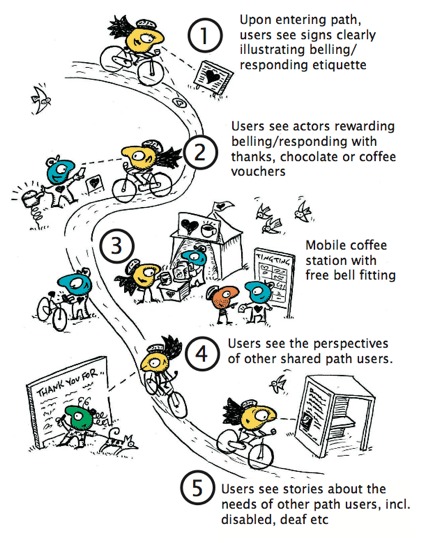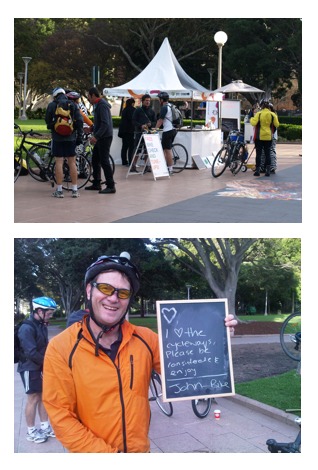You’d have to be living under a rock not to have heard about innovation lately. It’s the totally happening thing-du-jour, driven by the explosion of interest in Design Thinking (see, for example Mindlab, SILK and OpenIDEO).
Of course, innovation seems to be all about expensive consultants and time consuming processes. The challenge for the rest of us is to remake innovation/design thinking so we can apply it to our garden variety cash- and time-starved council or agency projects.
Recently, the City of Sydney cycling team asked me to facilitate a brainstorm for a campaign get cyclists using their bells and generally behaving more considerately on shared paths.
My response was: “If you have a brainstorm, you’ll get a slogan. Why not try something more interesting?”
So, instead of one 2-hour brainstorm, we took three mornings, a week apart. We invited a diversity of people along, 19 in all, including council staff, shared path users, interested players and experts.
Here’s what we did:
Morning 1: Information and inspiration
We briefed the participants on:
– the results of the social research and field observation council had previously undertaken on shared paths;
– our theory of change, which was that “if cyclists believe bell use is expected by other shared path users, then bell use will increase”; and
– inspiring campaign ideas from overseas, including ideas completely unrelated to cycling.
Morning 2: Brainstorming and concepting
In four teams, with the theory of change in mind, we went through a series of brainstorms that generated 12 different concepts for the campaign.
Here is how the workshop looked:
Morning 3: Evaluation A smaller group sat down, decided on criteria for assessment, and sorted through the concepts, coming up with a “winning set” – which is depicted in the illustration below.
In a spirit of openness the City of Sydney team have given me permission to share the full briefing, brainstorming process and 12 initial concepts. They’re all in the PDF file that appears at the end of this post.
Fast prototyping followed. On the principle of “fail early” we asked “What can we put in the field next week, even if we have to draw it by hand?” Actually, we had to wait a couple of weeks for benchmarking (measuring how many people already use bells etc) to be completed. The fast prototyping is now under way.
When it’s finished, we’ll ask: what have we learned? Then we’ll improve the recipe and repeat.
Here is the fast prototyping schedule. Maybe they’ll see you there!!!
Week 1 – 2: 21 – 23 June and 28 – 30 June (Tues, Wed, Thurs AM 7:30 – 9:00am) Where: College Street Shared path, across from St Mary’s Cathedral and down from the Archibald fountain.
Week 3 -4: 5-7 July and 12-14 July (Tues, Wed, Thurs AM 7:30 – 9:00am) Where: Cleveland Street Shared Path, Moore Park (near the Golf course exit).
Week 5-6: 19-21 July and 26 -28 July (Tues, Wed, Thurs AM 7:30 – 9:00am) Where: Prince Alfred Park, Chalmers Street entrance.
Overall: I’m pleased with this attempt at innovation-for-the-rest-of-us. It was a little more time consuming than a standard brainstorm, but the results speak for themselves. It activated the three necessary conditions for creativity: diversity of participants; informed and inspired participants; and enjoyment. And It came up with ideas that could never have arisen in a garden variety brainstorm.
What would I do differently next time? I think I’d work even harder to activate creativity. I’d start with a quick game to activate playfulness. Then I’d have a short “getting in the mood” brainstorm where the rule was that the answers had to appear ludicrous to the speaker. I think that would loosen people’s imaginations up even faster.
Here are some photos from the first day of fast prototyping.





Hi Les, just wanted to thankyou for sharing this ‘innovative’ session you conducted. (Also thanks to the City of Sydney cycling team for sharing too!). It’s not only helpful but inspiring when practitioners share great examples. Looking forward to hearing how the prototyping schedule goes. Great stuff!